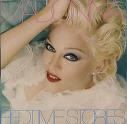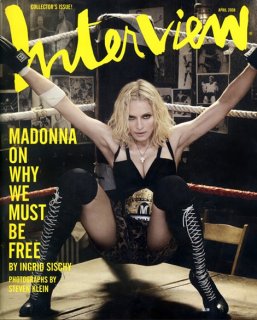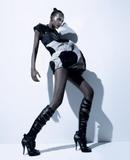Fabien Baron: One man renaissance
Coupland, Ken
The Midas Touch
No one man in the media design business is more powerful and influential than Fabien Baron today. He has orchestrated spectacularly successful advertising campaigns for an international design posse that includes fashion honchos (and honchas) Calvin Klein, Donna Karan, Giorgio Armani, Jil Sander, Burberry, Issey Miyake, Carolina Herrera and hotelier Ian Schrager. Most memorably, he has revitalized magazine designs for Harper's Bazaar, Interview, and Italian Vogue, to name some of the more prominent beneficiaries of the legendary Baron touch.
In fact, though he calls his agency Baron & Baron-when there is, in fact, only one Baron involved-it might be more appropriate to belabor the conceit and call his outfit Baron & Baron & Baron & Baron. The 43-year-old Frenchman has proved equally adept at fragrance packaging (for cK one), music videos (for Madonna), fashion photography and most recently, furniture and accessories (his eponymous line for the upscale Italian manufacturer Cappellini).
He could aptly be called a Renaissance man. "People have too much of a tendency to be put in that little box that has been assigned to them." Baron regrets, speaking from the offices in Manhattan he designed for himself and a bare-bones staff of 25. Pegged as a brilliant and innovative editorial art director early in his 20-year career, Baron has refused to be pigeonholed. "It's the point of view that matters in the end." Baron's signature embodies his point of view: stripped-down but savvy, classical but contemporary, tasteful but somehow borderline outrageous.
Baron is a Renaissance man in the literal sense of the term, too: he exemplifies rebirth. His overarching strategy is not to invent from the ground up, but to reinvent. His talent lies in being able to take some fabulous invalid-Calvin Klein's near-bankrupt label, Conde Nast's second-tier Harper's Bazaar, Burberry's all-but-defunct clothing line-and administer the tonic that spurs its recuperation.
Burberry, the once-stodgy British raincoat manufacturer, has blossomed under a Baron-directed ad campaign into a spectrum of successful products for all ages branded with the company's distinctive plaid. "He's direct, to the point, and very efficient in the way he works," Burberry CEO Rose Marie Bravo observes. "He's not one of those people who procrastinates. He gets it done right on the spot and moves on to the many other projects he's involved in."
Baron's take-charge approach has been apparent from the earliest beginnings of his career. Ink was already in his blood. His father was art director for Liberation (at the age of 12, Baron was peddling subscriptions of the left-wing daily door to door).
Design that's more than skin-deep
Baron first arrived in the U.S. in the early '80s. With poor language skills (he maintains he spoke virtually no English), and no one in the business he actually knew, the designer (then a mere 22) found himself adrift. New York in those days was a very different place than its present-day, buffed-up, sanitized reality. Crime-ridden and filthy, the city at the time was an intimidating place for a Parisian used to the relatively pristine conditions of a European capital. Yet Baron was stimulated. "It was very exciting, having that element of danger," he recalls. he explored the streets of SoHo and a then-deserted TriBeCa for days on end, soaking up gallery shows.
Oddly enough-he can't even explain why-Baron, in his first few days in the country, met with luminaries like Alex Liberman, who was then in the process of transforming Vanity Fair. Living in relative isolation in a pre-gentrification loft in the South Street Seaport, Baron took on any freelance assignment he could find.
The lone ranger
In a surprisingly quick ascension, and with a few disagreements riddling his path, he went on to his first regular gig designing Self. He then landed at GQ and eventually moved to New York Woman (later picked up by American Express), but disagreements with the publisher over where the magazine was headed prompted his departure. Baron then began a rapid rise in the New York magazine world that he's convinced took place because he was perceived as a designer who understood information and how to structure it. "My experience was in newspapers, so I already had a journalism background," he says now. "I was passionate about the beauty of design but I was also passionate about writing, which is necessary if you're working on a magazine. It's not good to only do pretty things."
Baron wasn't about to tackle a magazine he felt he couldn't reinvent. He remembers turning down, in the space of several weeks, offers to revamp both the French and American editions of Vogue. "I was sitting in my loft saying, 'How crazy, how stupid of me, I just said no to two Vogues,'" he laughs. "But I knew I couldn't do a proper job because I wouldn't have my freedom."
Baron allows that he was heavily influenced in his youth by French Vogue, particularly the work of risk-taking photographers Guy Bourdin and Helmut Newton. "These were my heroes before I left for New York," he says. Once established in the U.S., Baron quickly went to work emulating his icons by importing young, relatively untried European lensmen in a wildly popular ad campaign for Barney's, the Manhattan clothing store. Beginning in 1988 with Patrick Demarchelier and Peter Lindbergh, Baron soon added younger talents to his stable, including edgy "stylists" like David Sims and Mario Sorrenti.
Photographer Steven Klein-a Baron regular who freely mixes edgy editorial assignments with more mainstream commercial work-finds a unique satisfaction in the relationship. "Fabien gives you a lot of positive energy and always has a million ideas and directions." Klein notes, "I always go away feeling good about having worked with him, and I can't say this about many art directors." Despite his reluctance to tackle two sister publications, in 1988 Baron jumped at the chance to revive Italian Vogue for editor Franca Sozzani. After several years-during which he kept his New York City base to continue working on advertising-he gave up the job.
Exhausted by the rigors of airline travel to and from Milan, he accepted an invitation to re-imagine Interview. Overnight, Baron transformed the celebrity rag with crackling layouts and his distinctively stark treatment of photography. But after a year (1990) when Editor Ingrid Sischy reportedly began to resent the impact his redesign was having on her product, he was on the move again.
Celebrity Makeovers
1992 was a banner year marking Baron's entry into the lucrative merchandising field with a campaign for Calvin Klein fashion introducing top model Kate Moss and starting in 1994, packaging for the ailing label's cK one fragrance. That branding quickly became one of the most recognized worldwide-an all-time bestseller that quadrupled the company's sales, while earning the dubious distinction of being blatantly counterfeited in foreign markets. But it was Baron's makeover of Harper's Bazaar the same year that put his name on the international design map for keeps.
While readership soared, media pundits raved about the glossy magazine's radical redesign in its revived format. Baron, the critics claimed, had resurrected Alexey Brodovitch's iconic treatment of the venerable periodical. Curiously, Baron now says that he was initially unfamiliar with Brodovitch's masterwork. "I tell you honestly-and no one will believe me-that I knew he was a genius, but I had never looked at his work. And I said Tm not going to.'" Only after designing 3 or 4 issues did Baron consult the magazine's archives, discovering that his redesign was startlingly similar to the magazine's vintage style.
The next year, 1993, marked Baron's explosive entry into book design with Sex, Madonna's wildly controversial photographic collaboration with Steven Meisel. Once again comfortably segueing from medium to medium, Baron picked up a Super-8 video camera to document the pop star's shenanigans during photo shoots. Madonna liked what she saw so much that she invited him to film her musical performance. Baron became a music-video director.
Wearing more than one hat
Baron's ability to nurture and collaborate with many different photographers is genuinely rare among art directors. It's on full display in his latest magazine project where he was editor-in-chief until summer 2002 (surely a first for an art director) of the semi-annual British men's magazine Arena Homme Plus, (A+), where once again he is reinventing the form.
Arena weighs in at a hefty 400-odd pages replete with ads-fashion is one industry that refuses to reflect the economic downturn. A+ which evinces a hard-edged brilliance and take-no-prisoners editorial approach puts American men's clothing magazines to shame. Photographed by Steven Klein for an extensive feature spread in the Fall/Winter 2001 issue, teen heartthrob Justin Timberlake of the massively popular boy band *NSYNC is cast as a street punk-cumhustler. Klein has a track record for turning hetero sex symbols like actor Brad Pitt into simulacra of rough trade. With Timberlake, he pushes the voyeur factor a little further, showing the perennial pop sensation in p*rn-star poses (but discreetly semi-clothed) and, in another image, accessorized with a glowing, spray-painted phallus that sprouts proudly erect from the boy toy's jeans.
In a fascinating demonstration of the impact the events of September 11 had on media worldwide, the publishers of A+ opted days later to destroy the entire printed edition because the cover image Baron had chosen-an artfully doctored shot of Timberlake bleeding at the nose and mouth, wearing an American flag T-shirt was an uncanny reflection of the attacks.
Chameleon-like, the current issue for Spring/Summer 2002 swaps out type programs and introduces quirky new layout elements that give the latest installment a distinct identity, but that retain the streetwise sensibility that sets A+ apart from the cool classicism of magazine design with which Baron is associated. What remains constant in the magazine's design is its sexy, uninhibited photography, including a series of salacious spreads by Mikael Jansson that spiral into a frankly-documented sexual free-for-all.
With all his restlessness, it should come as no surprise that last year Baron gravitated to his own brand of interior design and furnishings, renovating the SoHo loft in which he lives as a setting for classic-some would say derivative-reinterpretations in a tightly edited series of minimalist modernist pieces. Could he finally be ready, then, to move on? While it's unlikely Baron will ever abandon the world of print entirely, in interviews he frequently expresses his passion for architecture, something he'd clearly like to try his hand at next. In fact, Baron says he's already drawn up plans for his future home in the Hamptons. As for what to expect from him there, he says, "If you look at my product design you have a pretty good idea of what I like. Clarity, simplicity, limpidity and light."
























 [URL=http://img404.imageshack.us/my.php?image=bossorangefw2006jeisa00xp1.jpg]
[URL=http://img404.imageshack.us/my.php?image=bossorangefw2006jeisa00xp1.jpg]










 when will the new interview magazine under him out?
when will the new interview magazine under him out?